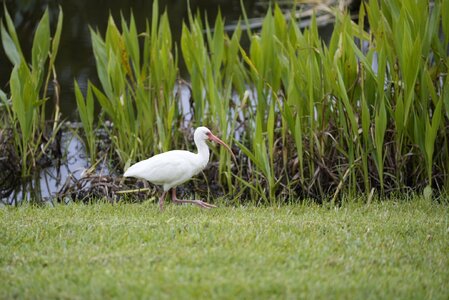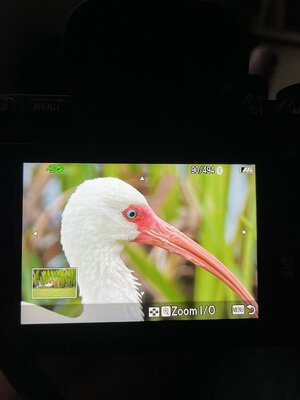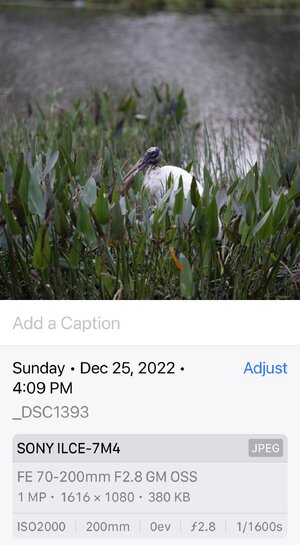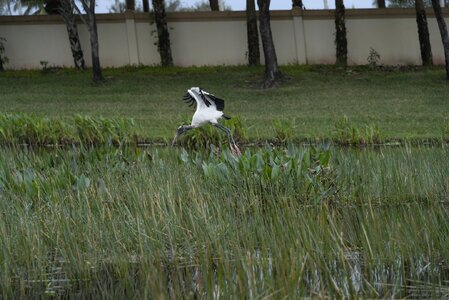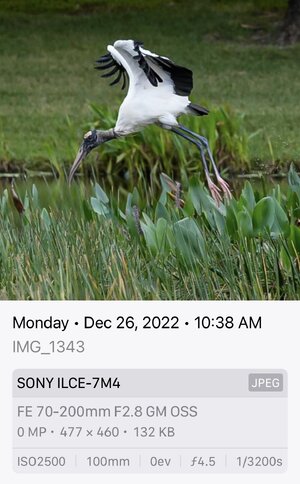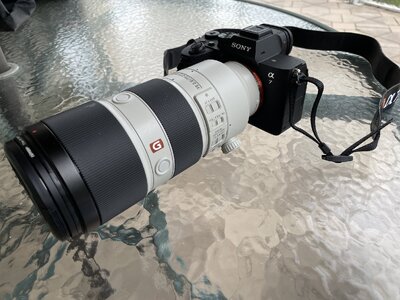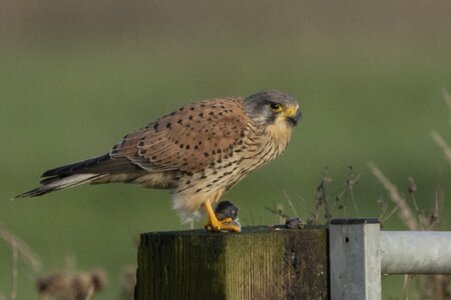I am currently using an A7IV with GM 70-200 to shoot birds. I’m a week away from purchasing the GM 200-600 but for now that’s my setup. Pretty straightforward issue - no matter what shutter speed, aperture, focus mode, focus area or any other setting I use (I keep ISO on auto and capped at like 2000-2500), the pictures look great on the camera’s monitor, even when I zoom in to check out sharpness and details. But as soon as I go to share to my iPhone via Imaging Edge, or the big culprit - cropping to bring the bird more into view and prominence in the shot - I wind up with a blurry, noisy bird. Pretty much every time. I recently moved from the a6100 to A7IV and I’ve had this issue with both camera bodies, so barring user error, I’m guessing that I am simply not using enough lens to shoot birds. No one that I know shoots birds with less than 300mm. I’m guessing that a 200-600 will help me crop a lot less and result in clearer images post processing but I’d like to be sure before making the investment. Thank you in advance for any input that you can provide.
Categories
Install the app
How to install the app on iOS
Follow along with the video below to see how to install our site as a web app on your home screen.
Note: This feature may not be available in some browsers.
More options
You are using an out of date browser. It may not display this or other websites correctly.
You should upgrade or use an alternative browser.
You should upgrade or use an alternative browser.
Sony A7 IV Cropped/Shared Images are Blurry
- Thread starter Embeeous
- Start date
Sony A7 IV Resources: Memory Card Tests | Accessories | Firmware | User Guide | Price Check: B&H Photo
D
Deleted Member 5003
Guest
Hello mb,
I don't see enough specifics in your post to analyse your problem but in the first instance would recommend you lift the autu iso setting, I do however believe you have an issue with your settings as I use both the 70-200 and the 200-600mm lenses and as many on this forum,\ am able to achieve high quality birding shots,including after cropping.
That aside you should have no issue using the 70-200 with an A7iv which your monitor post shot review seems to support.
Also in respect of the 200-600, many birders are using this lens, including many on this forum, and coupled with your a7iv should in general give your good quality images.
Suggest you review your settings and image metadata to solve the issue you describe.......
I don't see enough specifics in your post to analyse your problem but in the first instance would recommend you lift the autu iso setting, I do however believe you have an issue with your settings as I use both the 70-200 and the 200-600mm lenses and as many on this forum,\ am able to achieve high quality birding shots,including after cropping.
That aside you should have no issue using the 70-200 with an A7iv which your monitor post shot review seems to support.
Also in respect of the 200-600, many birders are using this lens, including many on this forum, and coupled with your a7iv should in general give your good quality images.
Suggest you review your settings and image metadata to solve the issue you describe.......
AlphaWorld
Veteran Member
- Followers
- 10
- Following
- 0
- Joined
- Apr 8, 2021
- Posts
- 1,348
- Likes Received
- 882
- Name
- Tony
I wonder if your restriction of the ISO is causing the shutter speed to drop? Shooting birds in flight at slower shutter speeds could easily be the source of your blur.
I set a minimum shutter speed of 1/2000 and let ISO go up to 12800 (to be honest - I cribbed that from Mark Galer's setup recommendations).
I would be less scared of higher ISO than of slow shutter speed. You can run the images through your choice of de-noise software to deal with the ISO noise, but nothing can fix an image shot at too low a shutter speed.
I set a minimum shutter speed of 1/2000 and let ISO go up to 12800 (to be honest - I cribbed that from Mark Galer's setup recommendations).
I would be less scared of higher ISO than of slow shutter speed. You can run the images through your choice of de-noise software to deal with the ISO noise, but nothing can fix an image shot at too low a shutter speed.
Site Supporter
- Followers
- 28
- Following
- 1
- Joined
- Aug 18, 2020
- Posts
- 3,789
- Likes Received
- 4,772
- Name
- Uncle Kev

- Country
- United Kingdom
- City/State
- Ormesby St Margaret
- CC Welcome
- Yes
I agree about the ISO restricting your shutter speeds. I cap mine at 10,000, because you can easily get away with it on these cameras, with a bit of photoshop work.
Site Supporter
- Followers
- 14
- Following
- 0
- Joined
- Oct 28, 2020
- Posts
- 3,402
- Likes Received
- 5,635
- Name
- Gary
- Country
- United Kingdom
You have your own answer 70-200 is a big ask if you are not on top of your bird, I often shoot birds with a 300 g 2.8 a -mount on an adaptor when the light is not good on 24 mp and that means I have to be careful with cropping. even with the 200-600 iso needs capping as the others replies said and shutter speed is also a factor, again as others say, too slow and its a deal breaker 9 times out of 10I am currently using an A7IV with GM 70-200 to shoot birds. I’m a week away from purchasing the GM 200-600 but for now that’s my setup. Pretty straightforward issue - no matter what shutter speed, aperture, focus mode, focus area or any other setting I use (I keep ISO on auto and capped at like 2000-2500), the pictures look great on the camera’s monitor, even when I zoom in to check out sharpness and details. But as soon as I go to share to my iPhone via Imaging Edge, or the big culprit - cropping to bring the bird more into view and prominence in the shot - I wind up with a blurry, noisy bird. Pretty much every time. I recently moved from the a6100 to A7IV and I’ve had this issue with both camera bodies, so barring user error, I’m guessing that I am simply not using enough lens to shoot birds. No one that I know shoots birds with less than 300mm. I’m guessing that a 200-600 will help me crop a lot less and result in clearer images post processing but I’d like to be sure before making the investment. Thank you in advance for any input that you can provide.
- Thread starter
- #6
Here is a good example of what I’m running into. This ibis was probably 15-20 feet away from me, walking slowly left to right. I crouched down to its level, held the camera firmly and took the shot in RAW. I’ve attached a few images - one of the original shot as seen zoomed in on my camera’s monitor, and a screenshot of the image as sent to my iPhone as a JPG with the metadata. I can further upload this image to SmugMug and take a screenshot of more data on the shot if that would be helpful. This wouldn’t even be a dramatic crop and yet as soon as I zoom in on the image off of the camera I start to see blur.
So what am I missing here? Not enough lens for even this close of a bird shot, or setting(s) that need to be changed? Oh someone asked, I shoot in straight up Manual mode with ISO auto capped at 2000-2500, I control shutter speed and aperture at all times.

So what am I missing here? Not enough lens for even this close of a bird shot, or setting(s) that need to be changed? Oh someone asked, I shoot in straight up Manual mode with ISO auto capped at 2000-2500, I control shutter speed and aperture at all times.
Attachments
- Thread starter
- #7
I realized after the fact that that last shot was taken at 1/250, might not have been a good example (not fast enough). Here’s another one similar timing lighting conditions and proximity and this bird was stationary. Tried a bunch of focus area options, all still blurry when zoomed in off of camera. What am I doing wrong?? I feel like I should be able to get sharp shots of close fairly immobile birds with the 70-200 but I’m not doing it on a regular basis.
Attachments
D
Deleted Member 5003
Guest
AS intimated further up in this mail string your autoiso is very low and i would think 5000 should be your minimum, dependant if you are shooting in low light on a regular basis and if you shoot in low light regularly you should consider a higher setting. The industry has moved on in the past 2-3 years and denoising software has improved greatly and even at ISO 5000-10,000 much of the image noise can be reduced/removed.
Your ibis shot seems to indicate the ibis was moving and at 1/250 shutter speed and f2.8, your DOF is very low, you can see this on the bird which is completely soft and grass exposure, and at 200mm and 1/250 it should not be surprising that your image is soft for a moving image
Your heron shot was taken of a static bird and whilst you do not state the shutter speed if you shot at 1/250 it again is not surprising your image is sharper however on all of your sample shots the birds eyes are soft and this needs to be addressed in your focussing. The A7Riv has a limited focussing capability for moving/flying birds but for static birds you should have no problem in achieving sharp eyes on your images. Seems you need to read up on focus settings and the various options to be used for bird /action shooting(try Mark Galers, Steve Perry's or Mark Smiths you tube videos as useful sources of info for resolving any such issues)
Given the light conditions of you sample shots, it seems you are using f2.8 constantly, which should not be necessary and suggest when light is favourable lift you aperture to 4-5.6 which is the sweet spot for the 70-200 lens this will achieve better sharpness and also open up your DOF unless you are trying to maximise Bokeh. Even at f4 the 70-200 should still give reasonable bokeh however.
hope this helps.
Your ibis shot seems to indicate the ibis was moving and at 1/250 shutter speed and f2.8, your DOF is very low, you can see this on the bird which is completely soft and grass exposure, and at 200mm and 1/250 it should not be surprising that your image is soft for a moving image
Your heron shot was taken of a static bird and whilst you do not state the shutter speed if you shot at 1/250 it again is not surprising your image is sharper however on all of your sample shots the birds eyes are soft and this needs to be addressed in your focussing. The A7Riv has a limited focussing capability for moving/flying birds but for static birds you should have no problem in achieving sharp eyes on your images. Seems you need to read up on focus settings and the various options to be used for bird /action shooting(try Mark Galers, Steve Perry's or Mark Smiths you tube videos as useful sources of info for resolving any such issues)
Given the light conditions of you sample shots, it seems you are using f2.8 constantly, which should not be necessary and suggest when light is favourable lift you aperture to 4-5.6 which is the sweet spot for the 70-200 lens this will achieve better sharpness and also open up your DOF unless you are trying to maximise Bokeh. Even at f4 the 70-200 should still give reasonable bokeh however.
hope this helps.
Site Supporter
- Followers
- 21
- Following
- 1
- Joined
- Oct 22, 2021
- Posts
- 4,944
- Likes Received
- 3,821
- Name
- Tim
- Country
- United States
- City/State
- SE Michigan
Not much to add. Raise ISO, raise shutter speed. Right now you're using a /2.8 lens. You're going to lose over 2 stops going to the 600 at full extension. That may feel odd or unsettling, join the club. I still struggle with setting ISO high worrying about noise, but the M4 can handle it. I shoot more often that I care to @ISO 8000 but try to overexpose then pull it back some in post, which helps with noise in the shadows.
The AF on the A7M4 is top-drawer, you should have no problem with it.
The crop on that IBIS' head is a LOT. I can make out the lines in your screen. A 200mm lens is only going to go so far.
Some programs downscale automatically for display. I don't know if any of those you're using do, but something to look into.
My backyard feeders are set up 16' away from where I sit. Even at that distance and with the 600, the images still need a lot of cropping to fill the screen with the bird, if that's the desired composition. These birds are much smaller than the IBIS so more cropping is expected. To me, 20' away from the IBIS with a 200mm lens would require a perfect shot.
Keep in mind too what your intended mode of display is. A computer screen, the shots are ok. Large print, not so much. Any time you crop you're spreading fewer pixels out over the same area, so it takes a good shot to stand up to cropping.
The AF on the A7M4 is top-drawer, you should have no problem with it.
The crop on that IBIS' head is a LOT. I can make out the lines in your screen. A 200mm lens is only going to go so far.
Some programs downscale automatically for display. I don't know if any of those you're using do, but something to look into.
My backyard feeders are set up 16' away from where I sit. Even at that distance and with the 600, the images still need a lot of cropping to fill the screen with the bird, if that's the desired composition. These birds are much smaller than the IBIS so more cropping is expected. To me, 20' away from the IBIS with a 200mm lens would require a perfect shot.
Keep in mind too what your intended mode of display is. A computer screen, the shots are ok. Large print, not so much. Any time you crop you're spreading fewer pixels out over the same area, so it takes a good shot to stand up to cropping.
D
Deleted Member 5003
Guest
Hello MB to avoid confusion , the A7Riv compared to the A1 or either of the A9 i or ii does not hold focus as well for moving objects/flying birds as has been widely acknowledged in photography circles and forums over the past 2-3 years and through personal experience of my shooting all 3 of these cameras.
Site Supporter
- Followers
- 21
- Following
- 1
- Joined
- Oct 22, 2021
- Posts
- 4,944
- Likes Received
- 3,821
- Name
- Tim
- Country
- United States
- City/State
- SE Michigan
Hey Sore Fined, It's not an R4, it's a 4. Even the thread tag says A7IV. And the 4 has top drawer AF. The A1 even had some of its attributes provided in a firmware update.
So yes, to avoid confusion...
So yes, to avoid confusion...
- Thread starter
- #13
Update - bumped the aperture up from 2.8 to 4.5 and kept the shutter speed in the 1600-3200 range, definitely an improvement. I also made it a point to keep the lens no more extended than 135mm, that also seemed to make a difference. I let the ISO creep up to like 3000-4000 and started to see a little grain/noise so I recapped it at 2500. Definitely an improvement but not quite there yet. Original JPG export to iPhone, and iPad Lightroom post versions attached.
Attachments
- Thread starter
- #15
I also want to acknowledge and thank Brownie, Deleted Member 5003, and everyone else who has commented on this message string. One of the most difficult things about being a new proud Sony user is finding specific advice tailored to the Sony platform. All of my buddies use Nikon and Canon, so it’s hard when I have questions like these, and Google isn’t much of a help sometimes. You guys have been AWESOME and I really and truly appreciate the quick and detailed responses. I look forward to returning the favor somehow but I would still consider myself a newbee. But not for long. Thank you all very much.
Site Supporter
- Followers
- 21
- Following
- 1
- Joined
- Oct 22, 2021
- Posts
- 4,944
- Likes Received
- 3,821
- Name
- Tim
- Country
- United States
- City/State
- SE Michigan
Everyone has knowledge to impart!I also want to acknowledge and thank Brownie, Deleted Member 5003, and everyone else who has commented on this message string. One of the most difficult things about being a new proud Sony user is finding specific advice tailored to the Sony platform. All of my buddies use Nikon and Canon, so it’s hard when I have questions like these, and Google isn’t much of a help sometimes. You guys have been AWESOME and I really and truly appreciate the quick and detailed responses. I look forward to returning the favor somehow but I would still consider myself a newbee. But not for long. Thank you all very much.
Site Supporter
- Followers
- 7
- Following
- 3
- Joined
- Aug 9, 2020
- Posts
- 1,387
- Likes Received
- 1,824
- Name
- Ralph Ernesti
- Country
- Australia
- City/State
- Mildura
- CC Welcome
- Yes
With the blur situation and I don't know if it has been said yet but I know one thing I use to do was as I pushed the shutter button down I was also pushing the camera down. And this caused the blur in the shot. It only happened by chance that I worked it out but when I felt what I was doing I worked on what I was doing and fixed the problem.
I am sorry if this has been said before but I know this was a problem I had and I was only using the much lighter Sigma 100/400mm lens.
I am sorry if this has been said before but I know this was a problem I had and I was only using the much lighter Sigma 100/400mm lens.
- Thread starter
- #18
Thanks. I set up back button focus on my A7IV the day I got it, so as to avoid that specific issue.With the blur situation and I don't know if it has been said yet but I know one thing I use to do was as I pushed the shutter button down I was also pushing the camera down. And this caused the blur in the shot. It only happened by chance that I worked it out but when I felt what I was doing I worked on what I was doing and fixed the problem.
I am sorry if this has been said before but I know this was a problem I had and I was only using the much lighter Sigma 100/400mm lens.
AlphaWorld
Veteran Member
- Followers
- 10
- Following
- 0
- Joined
- Apr 8, 2021
- Posts
- 1,348
- Likes Received
- 882
- Name
- Tony
You still have to press the shutter button to take the image, and if you have a vigorous shutter finger, that can move the camera.Thanks. I set up back button focus on my A7IV the day I got it, so as to avoid that specific issue.
One possible way to address that is to set the camera to shoot bursts, and capture two or three or more for each image - the first one might be blurred by camera movement, but the later ones in the burst may be better.
- Thread starter
- #20
Good point I had not thought about that. I do try to pay attention and keep the camera as steady as possible when depressing the shutter. And for bird photography I have it set for mid and hi bursts so hopeful that will help as well. Thank you.
Site Supporter
- Followers
- 28
- Following
- 1
- Joined
- Aug 18, 2020
- Posts
- 3,789
- Likes Received
- 4,772
- Name
- Uncle Kev

- Country
- United Kingdom
- City/State
- Ormesby St Margaret
- CC Welcome
- Yes
One thing to add. If you are shooting above 1/1250th or so, turn off the lens stabilisation, it can create blur as it tries to fight motion at your end that isn't there or noticeable. I am very steady so anything over 1/1000th is where I turn mine off, but 1/1600th is definitely a good cut off.
Site Supporter
- Followers
- 28
- Following
- 1
- Joined
- Aug 18, 2020
- Posts
- 3,789
- Likes Received
- 4,772
- Name
- Uncle Kev

- Country
- United Kingdom
- City/State
- Ormesby St Margaret
- CC Welcome
- Yes
Switching it off on the lens automatically switch off the IBIS.Do you turn it off on the lens, in the camera, or both?
Just to give an idea of what I mean, here's a shot I took at 1/1250th with stabilisation on. All of my shots at 1/1000th were sharp, I only upped it as the bird was moving, but not enough to cause blur as it happened. This is purely the effect of the stabilisation.
Attachments
- Thread starter
- #24
Very interesting. I had asked B&H about this previously and they had said don’t worry about it, it’s all automatic, kicks on when you need it and vice versa. I will most definitely give it a shot today when I up the shutter speeds above 1/1000 - 1/1250 and report back. The vast majority of input that I have received seems to indicate that the problem is not enough lens and cropping, but I’m willing to try anything at this point. Thank you.
photos.7777
Newcomer
- Followers
- 0
- Following
- 0
- Joined
- Oct 28, 2022
- Posts
- 1
- Likes Received
- 1
- Name
- BK
If the images are sharp when viewing in your camera and when you copy to a computer, it's possible that the iPhone is the culprit. The phone may be downsizing the quality when saving your image.I am currently using an A7IV with GM 70-200 to shoot birds. I’m a week away from purchasing the GM 200-600 but for now that’s my setup. Pretty straightforward issue - no matter what shutter speed, aperture, focus mode, focus area or any other setting I use (I keep ISO on auto and capped at like 2000-2500), the pictures look great on the camera’s monitor, even when I zoom in to check out sharpness and details. But as soon as I go to share to my iPhone via Imaging Edge, or the big culprit - cropping to bring the bird more into view and prominence in the shot - I wind up with a blurry, noisy bird. Pretty much every time. I recently moved from the a6100 to A7IV and I’ve had this issue with both camera bodies, so barring user error, I’m guessing that I am simply not using enough lens to shoot birds. No one that I know shoots birds with less than 300mm. I’m guessing that a 200-600 will help me crop a lot less and result in clearer images post processing but I’d like to be sure before making the investment. Thank you in advance for any input that you can provide.
Site Supporter
- Followers
- 21
- Following
- 1
- Joined
- Oct 22, 2021
- Posts
- 4,944
- Likes Received
- 3,821
- Name
- Tim
- Country
- United States
- City/State
- SE Michigan
Regarding ISO, none of us know what your background is, how long you've been shooting/processing, etc. Processing images is a whole different aspect, and something that takes time to learn like the rest of it. As I stated earlier, high ISO scares (scared) the crap out of me too. In some of the places I shoot, a missed opportunity can be more than just a disappointment, it can affect someone else and may never repeat itself. For those more critical shots I have always tended to err on the side of caution and shoot a lower ISO. I am slowly overcoming that.
There are many people on this forum who shoot higher ISO regularly and are very successful at it. Me? I'm still learning, as my background is one of 'base ISO only for better IQ'. The question is, how much better?
How many of your shots are going to be pixel peeped by others? The vast majority of people view images on a 3" iPhone screen, or maybe a tablet. Those who view images on a full-sized computer screen are few and far between, and are limited mostly to folks like us, avid photographers.
This shot was made with a 7M4, using a 30 year-old Minolta 80-200/2.8 and an LA-EA5 adapter. It is ISO 8000, shot in normal school gymnasium lighting. I used such a high ISO in order to be able to freeze action. Shutter speed is 1/1000, IBIS on. Clicking on the image will take you to Flickr where you can zoom in. Additionally, all of my images are reduced to 2500 pixels on the long side to improve upload time, and because we just don't need any more than that.
Would the image hold up to pixel peeping? Probably not. But in real life the odds of anyone doing so (unless I mention it!) is pretty slim. I am perfectly happy with the IQ and would have no problem printing this (in its original resolution) to a pretty large size, 16 x 20 or grreater.
 DSC08451 by telecast, on Flickr
DSC08451 by telecast, on Flickr
Play around with the settings without prematurely limiting yourself to lower ISOs out of habit. These cameras are capable of a lot.
There are many people on this forum who shoot higher ISO regularly and are very successful at it. Me? I'm still learning, as my background is one of 'base ISO only for better IQ'. The question is, how much better?
How many of your shots are going to be pixel peeped by others? The vast majority of people view images on a 3" iPhone screen, or maybe a tablet. Those who view images on a full-sized computer screen are few and far between, and are limited mostly to folks like us, avid photographers.
This shot was made with a 7M4, using a 30 year-old Minolta 80-200/2.8 and an LA-EA5 adapter. It is ISO 8000, shot in normal school gymnasium lighting. I used such a high ISO in order to be able to freeze action. Shutter speed is 1/1000, IBIS on. Clicking on the image will take you to Flickr where you can zoom in. Additionally, all of my images are reduced to 2500 pixels on the long side to improve upload time, and because we just don't need any more than that.
Would the image hold up to pixel peeping? Probably not. But in real life the odds of anyone doing so (unless I mention it!) is pretty slim. I am perfectly happy with the IQ and would have no problem printing this (in its original resolution) to a pretty large size, 16 x 20 or grreater.
 DSC08451 by telecast, on Flickr
DSC08451 by telecast, on FlickrPlay around with the settings without prematurely limiting yourself to lower ISOs out of habit. These cameras are capable of a lot.
Site Supporter
- Followers
- 28
- Following
- 1
- Joined
- Aug 18, 2020
- Posts
- 3,789
- Likes Received
- 4,772
- Name
- Uncle Kev

- Country
- United Kingdom
- City/State
- Ormesby St Margaret
- CC Welcome
- Yes
That's not at all accurate, as if that was the case there'd be no need to have an on/off switch!Very interesting. I had asked B&H about this previously and they had said don’t worry about it, it’s all automatic, kicks on when you need it and vice versa. I will most definitely give it a shot today when I up the shutter speeds above 1/1000 - 1/1250 and report back. The vast majority of input that I have received seems to indicate that the problem is not enough lens and cropping, but I’m willing to try anything at this point. Thank you.
Site Supporter
- Followers
- 21
- Following
- 1
- Joined
- Oct 22, 2021
- Posts
- 4,944
- Likes Received
- 3,821
- Name
- Tim
- Country
- United States
- City/State
- SE Michigan
Yes and no. There are definitely times when you want to turn IBIS off that have nothing to do with shutter speed. Examples include tripod mounting (although I've never seen a difference, personally) and panning, especially true if the camera or lens doesn't have a panning mode.That's not at all accurate, as if that was the case there'd be no need to have an on/off switch!
I am intrigued with the theory about shutting it off for fast shutters. Going to dig into it a bit and maybe do some testing,
Site Supporter
- Followers
- 28
- Following
- 1
- Joined
- Aug 18, 2020
- Posts
- 3,789
- Likes Received
- 4,772
- Name
- Uncle Kev

- Country
- United Kingdom
- City/State
- Ormesby St Margaret
- CC Welcome
- Yes
Yes and no. There are definitely times when you want to turn IBIS off that have nothing to do with shutter speed. Examples include tripod mounting (although I've never seen a difference, personally) and panning, especially true if the camera or lens doesn't have a panning mode.
I am intrigued with the theory about shutting it off for fast shutters. Going to dig into it a bit and maybe do some testing,
Yes I know there are times you need to switch it off, but if you take what B&H said literally, it would be fully automatic and therefore you'd not need it.
Regarding the shutting off of OSS. Every manufacturer says to do so somewhere in the small print that comes with lenses (as far as I know anyway) I know for certain Canon and Nikon do, and Tamron actually say that you should turn theirs off over 1/500th on the G2 lenses, as their system is different to others. I can verify that this is true. I lost a whole days flight shots through motion blur once before I knew this, despite shooting at 1/3200th on the day. Once I had that info all of my flight shots were fine. I'm sure Canon recommend over 1/1600th and Nikon 1/2500th (this is from memory). Anyway, it does make sense if you consider how the systems work, and I don't think you'll have trouble replicating the effect. It's something I've mentioned to a few people and one even said it was a revelation for his flight shots.
D
Deleted Member 5003
Guest
Dont agree the on/off switch is a function provided for only switching OSS/IBIS off at high shutter settings.
Tripod photography with or without a remote /cable shutter release also dictates whether to engage or switch off oss/ibis as it fights against resonate vibrations induced by pressing the on camera shutter button manually and equally where the age old 1/ lens focal length minimum shutter setting rule of thumb becomes more important for systems with or without OSS/IBIS.
In general whilst shooting on a sturdy tripod neither OSS or IBIS is recommended for above reasons.
The need to switch off OSS in hand holding is more concerned with older long lenses which may not have OSS full panning options(pan, vertical, and erratic)....this does not include the sony long lens line up of 70-200, 400mm prime, 200-600mm and beyond which have this.
To clarify IBIS provides for image stabilisation and corrects in camera whilst IBIS with OSS corrects in the lens....for lenses with no OSS but on a camera with IBIS you get a degree of image stabilisation but it is generally considered not as accurate as OSS/IBIS combined. As we know however Nikon and Canon provide camera stabilisation but not lens stabilisation whereas Sony only provide both on lenses greater than 200mm generally. I personally have also not seen recommended switching off of OSS/IBIS or its equivalent on any OSS/IBIS camera and lens combinations from Sony. On Canon and Nikon this may well be the case as they do not provide full OSS/IBIS equipped lens/camera combinations.
To cut to the chase shooting flying birds, hand held with long lenses, if you have multi panning option OSS and IBIS that will give better performance against selected bird motion in conjunction with high shutter speeds, but if you have IBIS only this will not give as good performance/sharpness and this may be the case for shutting it off irrespective of the shutter speed setting as long as you shutter speed is set above 1/max focal length minimum and you have a high grade autofocus and tracking system.
In summary neither the Sony GM 70-200mm, 400mm, 200-600mm or 600mm should require to shut off OSS/IBIS and should in fact enhance IQ.....this is also my personal experience.
Tripod photography with or without a remote /cable shutter release also dictates whether to engage or switch off oss/ibis as it fights against resonate vibrations induced by pressing the on camera shutter button manually and equally where the age old 1/ lens focal length minimum shutter setting rule of thumb becomes more important for systems with or without OSS/IBIS.
In general whilst shooting on a sturdy tripod neither OSS or IBIS is recommended for above reasons.
The need to switch off OSS in hand holding is more concerned with older long lenses which may not have OSS full panning options(pan, vertical, and erratic)....this does not include the sony long lens line up of 70-200, 400mm prime, 200-600mm and beyond which have this.
To clarify IBIS provides for image stabilisation and corrects in camera whilst IBIS with OSS corrects in the lens....for lenses with no OSS but on a camera with IBIS you get a degree of image stabilisation but it is generally considered not as accurate as OSS/IBIS combined. As we know however Nikon and Canon provide camera stabilisation but not lens stabilisation whereas Sony only provide both on lenses greater than 200mm generally. I personally have also not seen recommended switching off of OSS/IBIS or its equivalent on any OSS/IBIS camera and lens combinations from Sony. On Canon and Nikon this may well be the case as they do not provide full OSS/IBIS equipped lens/camera combinations.
To cut to the chase shooting flying birds, hand held with long lenses, if you have multi panning option OSS and IBIS that will give better performance against selected bird motion in conjunction with high shutter speeds, but if you have IBIS only this will not give as good performance/sharpness and this may be the case for shutting it off irrespective of the shutter speed setting as long as you shutter speed is set above 1/max focal length minimum and you have a high grade autofocus and tracking system.
In summary neither the Sony GM 70-200mm, 400mm, 200-600mm or 600mm should require to shut off OSS/IBIS and should in fact enhance IQ.....this is also my personal experience.
Sony A7 IV Resources: Memory Card Tests | Accessories | Firmware | User Guide | Price Check: B&H Photo
Similar threads
- Question
- Replies
- 17
- Views
- 563
- Replies
- 3
- Views
- 310
- Question
- Replies
- 3
- Views
- 431
New in Marketplace
-
-
-
For Sale Sony a7III Along with Sigma 35mm F1.4 Art DG HSM for Sony E
- Started by iwillcya
- Replies: 0

